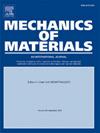Machine learning-based constitutive parameter identification for crystal plasticity models
IF 3.4
3区 材料科学
Q2 MATERIALS SCIENCE, MULTIDISCIPLINARY
引用次数: 0
Abstract
The crystal plasticity finite element (CPFE) method has emerged as an effective tool in probing the deformation mechanism of crystalline materials. A critical challenge in practical CPFE applications is the rapid and precise calibration of parameters for the crystal plasticity constitutive model, essential for accurate simulations. In this study, the machine learning method is employed to identify the parameters of the crystal plasticity constitutive model. The proposed machine learning method can directly determine the material parameters of the adopted constitutive model from experimentally obtained macroscopic tensile stress-strain curves. A proper Voronoi polycrystalline finite element model is established, and the uniaxial tensile stress-strain curves of polycrystalline copper (Cu) are calculated by using the adopted crystal plasticity constitutive model with different parameter combinations, thereby constructing a database for machine learning. The findings demonstrate that the stress-strain curves simulated from model parameters, as predicted by the machine learning method, align closely with the experimental results. Furthermore, feature importance analysis, utilizing the random forest algorithm, elucidates the relationship between the constitutive model parameters and the macroscopic stress-strain curve characteristics, such as yield stress and strain hardening rate. Additionally, the machine learning model, trained with the simulation data of Cu, is capable of determining the material parameters of other face-centered cubic metals, such as Ni, AISI 316L stainless steel and CrMnFeCoNi HEA, showcasing its extensive utility.

基于机器学习的晶体塑性模型本构参数辨识
晶体塑性有限元(CPFE)方法是研究晶体材料变形机理的有效工具。在实际CPFE应用中,一个关键的挑战是晶体塑性本构模型参数的快速和精确校准,这对于准确的模拟至关重要。本研究采用机器学习方法对晶体塑性本构模型参数进行识别。提出的机器学习方法可以从实验得到的宏观拉伸应力-应变曲线中直接确定所采用的本构模型的材料参数。建立合适的Voronoi多晶有限元模型,利用所采用的不同参数组合的晶体塑性本构模型计算多晶铜(Cu)的单轴拉伸应力-应变曲线,构建用于机器学习的数据库。研究结果表明,机器学习方法预测的模型参数模拟的应力应变曲线与实验结果吻合较好。此外,利用随机森林算法进行特征重要性分析,阐明了本构模型参数与屈服应力、应变硬化率等宏观应力-应变曲线特征之间的关系。此外,利用Cu的模拟数据训练的机器学习模型能够确定其他面心立方金属的材料参数,如Ni、AISI 316L不锈钢和CrMnFeCoNi HEA,显示出其广泛的实用性。
本文章由计算机程序翻译,如有差异,请以英文原文为准。
求助全文
约1分钟内获得全文
求助全文
来源期刊

Mechanics of Materials
工程技术-材料科学:综合
CiteScore
7.60
自引率
5.10%
发文量
243
审稿时长
46 days
期刊介绍:
Mechanics of Materials is a forum for original scientific research on the flow, fracture, and general constitutive behavior of geophysical, geotechnical and technological materials, with balanced coverage of advanced technological and natural materials, with balanced coverage of theoretical, experimental, and field investigations. Of special concern are macroscopic predictions based on microscopic models, identification of microscopic structures from limited overall macroscopic data, experimental and field results that lead to fundamental understanding of the behavior of materials, and coordinated experimental and analytical investigations that culminate in theories with predictive quality.
 求助内容:
求助内容: 应助结果提醒方式:
应助结果提醒方式:


